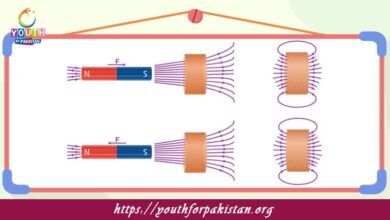Concept Of Orbital’s MDCAT MCQs with Answers

Welcome to the Concept Of Orbital’s MDCAT MCQs with Answers. In this post, we have shared Concept Of Orbital’s Multiple Choice Questions and Answers for PMC MDCAT 2024. Each question in MDCAT Chemistry offers a chance to enhance your knowledge regarding Concept Of Orbital’s MCQs in this MDCAT Online Test.
An orbital is defined as:
a) A region of space where electrons are likely to be found
b) The path an electron takes around the nucleus
c) The number of protons in the nucleus
d) The distance between two electrons
Which of the following is the correct shape of a p-orbital?
a) Spherical
b) Dumbbell-shaped
c) Double dumbbell-shaped
d) Complex
The s-orbital is characterized by:
a) Two lobes
b) Four lobes
c) Spherical shape
d) Dumbbell shape
How many orbitals are there in the p-sublevel?
a) 1
b) 2
c) 3
d) 4
Which of the following orbitals has the highest energy?
a) 2s
b) 2p
c) 3s
d) 3p
The number of orbitals in the d-sublevel is:
a) 1
b) 2
c) 5
d) 7
Which quantum number determines the shape of an orbital?
a) Principal quantum number
b) Azimuthal quantum number
c) Magnetic quantum number
d) Spin quantum number
The magnetic quantum number (mₗ) describes:
a) The size of the orbital
b) The shape of the orbital
c) The orientation of the orbital
d) The spin direction of the electron
How many electrons can a single s-orbital hold?
a) 1
b) 2
c) 6
d) 10
The p-orbitals are oriented along:
a) The x, y, and z axes
b) The x and y axes
c) The z axis only
d) The xy plane
Which of the following correctly describes the d-orbitals?
a) Spherical shape
b) Dumbbell shape
c) Four-lobed shape
d) Double dumbbell shape
In the Aufbau principle, electrons fill orbitals:
a) In order of increasing energy
b) In order of decreasing energy
c) Randomly
d) Only when the orbitals are half-filled
The Pauli exclusion principle states that:
a) No two electrons in an atom can have the same set of quantum numbers
b) Electrons fill orbitals from lowest to highest energy
c) Orbitals of the same energy are filled singly before pairing begins
d) The energy of orbitals increases as the principal quantum number increases
Which orbital has the lowest energy?
a) 2p
b) 3s
c) 3p
d) 4s
The shape of a d-orbital is often described as:
a) Spherical
b) Dumbbell
c) Double dumbbell
d) Four-lobed
The maximum number of electrons that can occupy the 3d orbitals is:
a) 2
b) 6
c) 10
d) 14
Which of the following orbitals has the highest angular momentum?
a) s-orbital
b) p-orbital
c) d-orbital
d) f-orbital
How many electrons can the f-orbitals hold in total?
a) 2
b) 6
c) 10
d) 14
The azimuthal quantum number (l) for a p-orbital is:
a) 0
b) 1
c) 2
d) 3
Which of the following describes the shape of an s-orbital?
a) Dumbbell
b) Spherical
c) Four-lobed
d) Double dumbbell
The number of orbitals in the f-sublevel is:
a) 1
b) 3
c) 5
d) 7
Which quantum number specifies the size of an orbital?
a) Principal quantum number
b) Azimuthal quantum number
c) Magnetic quantum number
d) Spin quantum number
In a given atom, the number of orbitals in the s-sublevel is:
a) 1
b) 2
c) 3
d) 5
Which quantum number defines the orientation of an orbital in space?
a) Principal quantum number
b) Azimuthal quantum number
c) Magnetic quantum number
d) Spin quantum number
Which of the following orbitals are degenerate?
a) 2s and 2p
b) 3s and 3p
c) 3p
d) 3d and 4s
How many electrons can be accommodated in the 2p orbitals?
a) 2
b) 6
c) 10
d) 14
The term “degenerate orbitals” refers to:
a) Orbitals with the same energy
b) Orbitals with different shapes
c) Orbitals with different sizes
d) Orbitals with different orientations
In an atom, the number of orbitals in the s-sublevel is:
a) 1
b) 2
c) 3
d) 5
The shape of a 3d-orbital is often described as:
a) Spherical
b) Dumbbell
c) Four-lobed or double dumbbell
d) Complex
Which orbital is represented by the quantum number l = 2?
a) s-orbital
b) p-orbital
c) d-orbital
d) f-orbital
The spin quantum number (mₛ) describes:
a) The orientation of an orbital
b) The shape of an orbital
c) The energy level of an orbital
d) The spin direction of an electron
Which of the following orbitals has the most complex shape?
a) s
b) p
c) d
d) f
The principal quantum number (n) indicates:
a) The size of the orbital
b) The shape of the orbital
c) The orientation of the orbital
d) The spin direction of the electron
Which of the following orbitals is filled last in the electron configuration of an atom?
a) s-orbital
b) p-orbital
c) d-orbital
d) f-orbital
How many different orientations are there for the p-orbitals?
a) 1
b) 2
c) 3
d) 4
In the d-sublevel, the maximum number of electrons is:
a) 2
b) 6
c) 10
d) 14
Which of the following is true about f-orbitals?
a) They have 1 orientation
b) They can hold up to 14 electrons
c) They are spherical
d) They have 3 orientations
The term “quantum numbers” refers to:
a) The number of protons in an atom
b) The number of neutrons in an atom
c) The numbers used to describe the properties of orbitals and electrons
d) The total number of electrons in an atom
In an atom, the 4f orbitals are:
a) Spherical
b) Dumbbell-shaped
c) Double dumbbell-shaped
d) Complex with 7 orientations
Which quantum number is associated with the orientation of the orbital in space?
a) Principal quantum number
b) Azimuthal quantum number
c) Magnetic quantum number
d) Spin quantum number
If you are interested to enhance your knowledge regarding Physics, Chemistry, Computer, and Biology please click on the link of each category, you will be redirected to dedicated website for each category.





